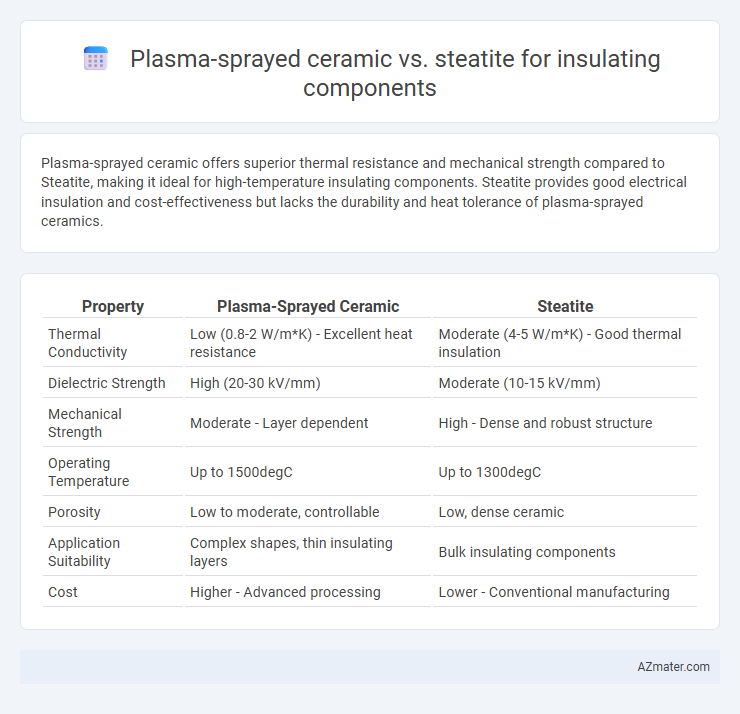Plasma-sprayed ceramic offers superior thermal resistance and mechanical strength compared to Steatite, making it ideal for high-temperature insulating components. Steatite provides good electrical insulation and cost-effectiveness but lacks the durability and heat tolerance of plasma-sprayed ceramics.
Table of Comparison
| Property | Plasma-Sprayed Ceramic | Steatite |
|---|---|---|
| Thermal Conductivity | Low (0.8-2 W/m*K) - Excellent heat resistance | Moderate (4-5 W/m*K) - Good thermal insulation |
| Dielectric Strength | High (20-30 kV/mm) | Moderate (10-15 kV/mm) |
| Mechanical Strength | Moderate - Layer dependent | High - Dense and robust structure |
| Operating Temperature | Up to 1500degC | Up to 1300degC |
| Porosity | Low to moderate, controllable | Low, dense ceramic |
| Application Suitability | Complex shapes, thin insulating layers | Bulk insulating components |
| Cost | Higher - Advanced processing | Lower - Conventional manufacturing |
Overview of Electrical Insulation Materials
Plasma-sprayed ceramics provide superior electrical insulation due to their high dielectric strength and thermal stability, making them ideal for high-voltage and high-temperature applications. Steatite, a magnesium silicate ceramic, offers good electrical insulation and mechanical durability but generally exhibits lower thermal resistance compared to plasma-sprayed ceramics. Selecting between plasma-sprayed ceramics and steatite depends on specific electrical insulation requirements, including voltage rating, thermal environment, and mechanical stress tolerance.
Introduction to Plasma-Sprayed Ceramic Insulation
Plasma-sprayed ceramic insulation offers superior thermal resistance and durability compared to steatite, making it ideal for high-temperature industrial applications. The plasma spraying process deposits fine ceramic particles onto substrates, creating a dense, uniform coating with excellent electrical insulation properties and resistance to thermal shock. This advanced technique allows for tailored thickness and microstructure, enhancing performance in demanding environments where traditional steatite insulation may degrade or fail.
Understanding Steatite as an Insulating Material
Steatite, a natural ceramic composed primarily of magnesium silicate, offers excellent electrical insulation properties combined with high mechanical strength and thermal stability. Its low dielectric constant and high resistance to thermal shock make it ideal for insulating components in electrical and electronic applications. Compared to plasma-sprayed ceramics, steatite provides a cost-effective and reliable solution with consistent performance in high-voltage and high-temperature environments.
Material Composition and Microstructure Comparison
Plasma-sprayed ceramic coatings typically consist of materials like alumina, zirconia, or yttria-stabilized zirconia, providing a dense, layered microstructure with high porosity control and fine grain distribution, which enhances thermal insulation and mechanical strength. In contrast, Steatite is a naturally occurring magnesium silicate ceramic with a crystalline microstructure characterized by needle-like talc fibers embedded in a dense alumina matrix, offering excellent electrical insulation and thermal shock resistance. The plasma-sprayed ceramic's engineered microstructure allows for tailored thermal barriers and wear resistance, whereas Steatite's homogeneous mineral composition results in consistent dielectric properties and robustness under high voltage conditions.
Thermal Insulation Properties: Plasma-Sprayed Ceramic vs Steatite
Plasma-sprayed ceramic coatings exhibit superior thermal insulation properties compared to steatite, with thermal conductivities typically ranging from 0.5 to 3 W/m*K, enabling them to withstand higher temperatures and provide effective heat resistance up to 1200degC. Steatite, a magnesium silicate ceramic, generally has a thermal conductivity around 4 to 6 W/m*K, offering moderate insulation but lower temperature tolerance, usually up to 900degC. The lower thermal conductivity and higher thermal stability of plasma-sprayed ceramics make them preferable for advanced insulating components in high-temperature applications.
Electrical Resistivity and Dielectric Strength
Plasma-sprayed ceramic coatings exhibit significantly higher electrical resistivity, often exceeding 10^12 ohm-cm, compared to steatite, which typically ranges around 10^10 ohm-cm. The dielectric strength of plasma-sprayed ceramics can reach up to 25-30 kV/mm, surpassing steatite's average values of 10-15 kV/mm, making plasma-sprayed ceramics more effective for high-voltage insulation applications. Furthermore, plasma-sprayed ceramics provide enhanced thermal stability and resistance to electrical breakdown under harsh environmental conditions.
Mechanical Strength and Durability Differences
Plasma-sprayed ceramic coatings exhibit superior mechanical strength compared to steatite due to their dense microstructure and strong adhesion to substrates, making them more resistant to cracking and wear under mechanical stress. Steatite, a magnesium silicate ceramic, offers good insulation but lower fracture toughness and is more prone to chipping and degradation over time under cyclic loading. The enhanced durability of plasma-sprayed ceramics results from their ability to form uniform, crack-resistant layers that maintain insulation properties even in harsh thermal and mechanical environments.
Cost Analysis and Manufacturing Considerations
Plasma-sprayed ceramic coatings typically involve higher upfront equipment and operational costs compared to steatite, due to sophisticated thermal spray systems and skilled labor requirements. Steatite, being a naturally occurring ceramic with simpler processing methods such as pressing and sintering, offers lower manufacturing expenses and ease of scalability for mass production. Cost analysis reveals plasma-sprayed ceramics deliver superior thermal and wear resistance at a premium, whereas steatite provides a cost-effective insulation solution with moderate performance for less critical applications.
Application Suitability: Industry Use Cases
Plasma-sprayed ceramic coatings offer superior thermal resistance and durability, making them ideal for high-temperature applications in aerospace, automotive exhaust systems, and industrial gas turbines. Steatite, known for its excellent electrical insulation and mechanical strength at moderate temperatures, is commonly used in electrical components, microwave technologies, and domestic appliances. Selection depends on operating temperature, mechanical stress, and environmental exposure, with plasma-sprayed ceramics favored for extreme thermal environments and steatite preferred for electrical insulation under lower thermal loads.
Future Trends in Insulating Components Technology
Plasma-sprayed ceramic coatings demonstrate superior thermal resistance and mechanical durability compared to traditional steatite insulating components, driving a shift towards high-performance applications in electronics and aerospace industries. Emerging trends emphasize nano-structured ceramic coatings that enhance insulation efficiency, reduce weight, and improve longevity under extreme conditions. Advancements in additive manufacturing and surface engineering technologies promise to further optimize plasma-sprayed ceramics for next-generation insulating components.

Infographic: Plasma-sprayed ceramic vs Steatite for Insulating component
 azmater.com
azmater.com